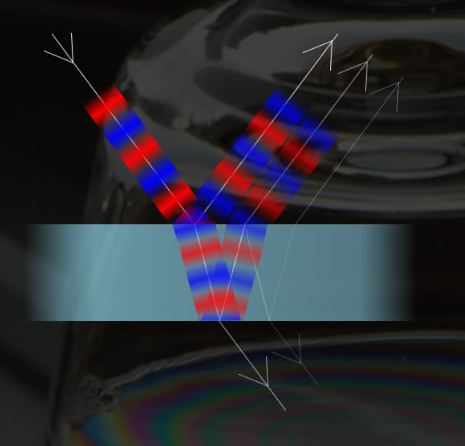Kitchen optics ~ Structural Colour
Kitchen Optics: Exploring the World of Structural Colour
Have you ever noticed the mesmerizing colors that appear on soap bubbles or oil films on puddles? These vibrant hues are not just random occurrences but rather a fascinating phenomenon known as structural color. In this article, we will delve into the world of kitchen optics and explore the captivating science behind structural color.
Structural color effects in soap bubbles, oil films, and other materials are a result of the interaction between light waves and bulk matter. Unlike the colors observed in a cloud corona, which arise from interference between light waves scattered by single droplets, structural colors in soap bubbles and oil films emerge from the reflection, refraction, and interference of light waves as they pass through or interact with these thin layers of material.
The simplest form of structural color is thin film interference, which gives rise to the enchanting hues seen in soap bubbles. When light strikes a thin film, some of it is reflected from the front surface, while some enters the film, reflects off the rear surface, and leaves in the same direction as the directly reflected wave. If the wave crests of these two outgoing waves coincide, they combine and produce light. However, if they are out of phase, destructive interference occurs, resulting in darkness.
The appearance of colors in soap bubbles is dependent on various factors such as viewing direction, thickness, and optical properties of the film. As the film drains or evaporates, its thickness alters, causing the colors to change right before our eyes. Thicker or thinner areas of the film create concentric rings of different colors. This phenomenon can be observed by closely examining the soap film left behind while drying the dishes.
Structural color is not limited to soap bubbles; it manifests in various forms throughout nature. Multilayer interference, diffraction grating effects, light scattering, and photonic crystal scattering contribute to the stunning colors seen in butterfly wings, peacock displays, opals, and the scales of fishes. Each of these instances showcases the intricate beauty and complexity of structural color.
To better understand the structural color effects in soap films, let's consider the images captured by Frank Le Blancq. These photographs exhibit soap films with hues and intricacy reminiscent of a cloud corona. By analyzing the films, we can gain insights into their thickness and composition. Observing the colored rings formed by the films, we can determine whether they are thicker at the edge or center.
In conclusion, kitchen optics offers a fascinating glimpse into the world of structural color. From the captivating hues of soap bubbles to the iridescence of butterfly wings, structural color effects are a testament to the intricate interplay between light and matter. By exploring these optical phenomena, we can gain a deeper appreciation for the beauty that surrounds us and the wonders of nature's palette.

Soap Film Colours seen by Frank Le Blancq of Jersey while drying the dishes. Optical effects are everywhere if we care to look. Unedited images �Frank Le Blancq.
The film's colours have the hues and complexity of those seen in a cloud corona. Both are light wave interference effects but there is a major difference.
A corona�s (or a glory�s) colours arise from interference between light waves scattered by single droplets.
The colours of soap bubbles or oil films on puddles are structural colour effects arising from reflection, refraction and interference of light waves as they pass through or interact with bulk matter. The other source of bulk colour is of course that produced by the selective absorption of pigments.
The colours of bubbles are from thin film interference, the simplest type of structural colour. More complex types: multilayer interference, diffraction grating effects ,light scattering and photonic crystal scattering give us the beauty of some butterfly wings, the iridescent panoply of a peacock�s display, the flashes of an opal and the shimmering scales of fishes. Expect OPODs about them.
When light strikes a thin film, some is reflected from the front surface. Some enters the film, reflects off the rear surface and leaves in the same direction as the directly reflected wave. When the film is thin enough the two outgoing waves combine. If their wave crests (shown red for positive and blue for negative at left) coincide then there is light. When they are out of phase there is destructive interference and there is darkness.
Whether there is light or darkness depends on the viewing direction and the thickness and optical properties of the film. We see the colours of soap bubbles changing before our eyes as the film drains or evaporates and alters in thickness.
Films that are thicker or thinner at their centre show coloured rings.
Are Frank Le Blancq's films thicker at the edge or centre?

Note: this article has been automatically converted from the old site and may not appear as intended. You can find the original article here.
Reference Atmospheric Optics
If you use any of the definitions, information, or data presented on Atmospheric Optics, please copy the link or reference below to properly credit us as the reference source. Thank you!
-
<a href="https://atoptics.co.uk/blog/kitchen-optics-structural-colour/">Kitchen optics ~ Structural Colour</a>
-
"Kitchen optics ~ Structural Colour". Atmospheric Optics. Accessed on December 22, 2024. https://atoptics.co.uk/blog/kitchen-optics-structural-colour/.
-
"Kitchen optics ~ Structural Colour". Atmospheric Optics, https://atoptics.co.uk/blog/kitchen-optics-structural-colour/. Accessed 22 December, 2024
-
Kitchen optics ~ Structural Colour. Atmospheric Optics. Retrieved from https://atoptics.co.uk/blog/kitchen-optics-structural-colour/.